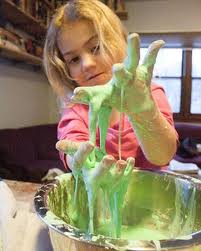#1
Grade Level: 4th-7th Type: Physics
Objective:
Make a hovercraft that can stay afloat using air power.
Research Question:
How does a flat surface move differently along another one when there’s air flowing under it?
Materials:
- Old CD
- Sports cap (pop-up type) from a disposable water bottle
- Glue
- Small or medium-sized balloon
Experimental Procedure:
- Use a CD that nobody wants to keep; it will get wrecked!
- Glue the sports cap to the CD so that the bottom of it is centered over the hole in the CD. Make sure it’s well-glued all the way around, and the sports top opens and closes easily.
- Wait for the glue to dry completely. Depending on the type of glue, you might have to leave it to dry overnight.
- Close the top of the sports cap and put the CD flat-side-down on a tabletop. Blow up the balloon and pinch the neck shut so no air gets out. Carefully stretch the neck of the balloon around the closed sports top so the part you drink out of is totally covered. There’s your hovercraft!
- Now put the hovercraft on a flat surface, like a table, and give it a little push to see how far it goes.
- Holding the hovercraft down, pull open the sports cap with the balloon still on it. Do this carefully—make sure the cap doesn’t come unglued!
- Now give the hovercraft another little shove and watch it go! What just happened? The air from the balloon is flowing through the spout now; when the CD was on the table with no air flow, the friction between the two flat surfaces kept it from going far. With air flowing between them, there’s a lot less contact between the surfaces and therefore a lot less friction—nothing to stop the hovercraft from really going!
Terms/Concepts: Friction, air pressure
References: Phineas and Ferb Science Lab, published by Scholastic, Inc., pp. 30-31 (2011).
#2
Grade Level: K-6th Type: Biopsychology/Sensory Perception
Objective:
Explore and compare the accuracy of the senses of smell and hearing.
Research Question:
How accurately can I identify sounds using only my sense of hearing? How accurately can I identify objects using only my sense of smell? Which of these senses is more accurate?
Materials:
- Computer to play .wav files of recorded sounds (I have several)
- Sound stimuli should include common sounds that are dissimilar from each other, such as the sound of water, breaking ice, footsteps, fire, wind, etc.
- Name the files with numbers, so they are named innocuously. In this way, participants can play the files themselves.
- Several small containers for the scent items
- Scent stimuli should include common scents that are dissimilar from each other, such as fresh fruit (pineapple, lemon, strawberry), and common environmental items such as a pine cone, soap, a flower, etc.
- Using Starbucks cups (for hot drinks) with lids work well. Place the scent item in the cup and place crumpled paper on top of the item before affixing the lid. Participants should be told not to handle the cups.
- Label each cup with a number.
- Worksheet to record, tally, and analyze results
Experimental Procedure:
- Participants listen to, or smell, each stimulus and record their answers on their worksheet
- The worksheet asks them to reason/explain/describe why they believe their answer to be true.
- When done, they check their answers against the key, and assign a numeric value to their correct and incorrect answers.
- Once values are assigned, they compare their sense of smell to their hearing and discuss why they think they got the results they did.
- The worksheet then asks them to brainstorm – how might knowing this help them in class, at home, or in life?
- Finally, they need to add their total score and post it on the white board (left side if hearing their hearing was better, right side if their sense of smell was better)
- OPTIONAL: At the bottom of the board, write advice to teachers (for example, “I don’t hear very well, talk less”)
References: I created this one.



